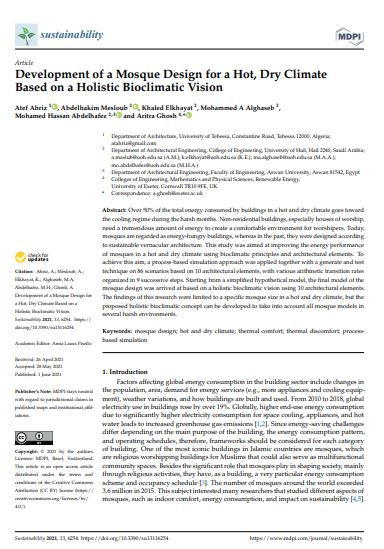
Over 50% of the total energy consumed by buildings in a hot and dry climate goes toward the cooling regime during the harsh months. Non-residential buildings, especially houses of worship, need a tremendous amount of energy to create a comfortable environment for worshipers. Today, mosques are regarded as energy-hungry buildings, whereas in the past, they were designed according to sustainable vernacular architecture. This study was aimed at improving the energy performance of mosques in a hot and dry climate using bioclimatic principles and architectural elements. To achieve this aim, a process-based simulation approach was applied together with a generate and test technique on 86 scenarios based on 10 architectural elements, with various arithmetic transition rates organized in 9 successive steps. Starting from a simplified hypothetical model, the final model of the mosque design was arrived at based on a holistic bioclimatic vision using 10 architectural elements. The findings of this research were limited to a specific mosque size in a hot and dry climate, but the proposed holistic bioclimatic concept can be developed to take into account all mosque models in several harsh environments.
Ahriz, Atef, Abdelhakim Mesloub, Khaled Elkhayat, Mohammed A. Alghaseb, Mohamed Hassan Abdelhafez, and Aritra Ghosh. “Development of a mosque design for a hot, dry climate based on a holistic bioclimatic vision.” Sustainability 13, no. 11 (2021): 6254.
I agree to the terms outlined below:
You agree to upload and assign Mosqpedia Database the rights to use the content worldwide and in perpetuity across all current and future media platforms. Mosqpedia Database may edit, copy, adapt and translate your contribution.
The content will be distributed under the Creative Commons Attribution-Deed – Attribution-NonCommercial-NoDerivatives 4.0 International – Creative Commons
All data will be stored in line with data protection regulations.